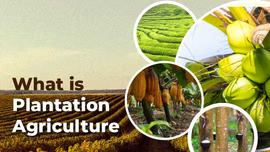Silviculture in India: Types, Importance and Objective

Silviculture is the practice of growing, managing, and caring for forest to meet both ecological and economic needs, ranging from timber production to forest & wildlife conservation. It focuses on technique like planting, thinning and harvesting trees in a sustainable way. In this blog, we’ll explore the silviculture process along with its objective, types of silviculture systems, important trees under silviculture, and its future prospects.
Table of Contents
- What is Silviculture?
- What are the Objectives of Silviculture?
- What are the Types of Silviculture Systems?
- Silviculture of Important Tree Species
- What is the Scope of Silviculture in India?
What is Silviculture?
Silviculture is the art and science of cultivating forest. It is a branch of forestry that focuses on scientific cultivation, management and regeneration of forests. It involves selecting tree species suited to different climates and soils, adopting techniques to enhance their growth and ensuring sustainable harvesting without depleting the environment. In India, Silviculture is considered important practice as it is crucial for restoring degraded land, conserving biodiversity, combating desertification and supporting tribal communities who live in or around these forests and are dependent on them for livelihood.
Why is Silviculture Important in India?
Here are some of the key reasons why silviculture is especially important in India:
Restoring and Expanding Forests for Ecological Stability: Silviculture plays an important role in reforesting degraded lands, controlling soil erosion and enhancing landscape resilience. These interventions are essential in India where ecosystem is extremely diverse.
Safeguarding Biodiversity and Ecosystem Health: Silviculture contributes to the preservation of animal habitat and the conservation of biodiversity through the careful management of species composition and forest structure.
Supporting Livelihood & Sustainable Resource Use: It promotes sustainable harvesting of timber and non-timber forest products, which many rural and tribal communities depend on. Joint forest management efforts such as these ensure forests benefit the locals without negatively impacting ecological balance.
Mitigating Climate Change: The practice of Silviculture helps make ecosystem more resilient to climate shifts as it promotes a forest structure that is more resilient to climate stressors.
What are the Objectives of Silviculture?
Silviculture is defined as reforestation and regeneration. It means planting new trees or rejuvenating old trees. It has several objectives, such as:
- Ensuring natural or artificial renewal of trees for the purpose of reforestation and fixing degraded land.
- Meeting demands for wood, bamboo, timber and other forest products without exhausting resources.
- Protecting watersheds, preventing soil erosion and improving soil fertility.
- To produce other indirect effects, such as to regulate the drainage, climatic conditions and its influence, etc.
- Enhancing carbon sequestration and fostering climate-resilient forest ecosystems, while also generating carbon credits that can support sustainable development and incentivise conservation efforts.
What are the Types of Silviculture Systems?
There are two types of silviculture systems based on the mode of regeneration. These are:
High Forest Systems
The high forest system is basically about the seedling origin, either natural or artificial, and where there is a long rotation. These are further classified into the following sub-systems:
- Clear-felling System
- Uniform System
- Group System
- Shelterwood System
- Selection System
Coppice Systems
In this type of silviculture system, the rotation of the coppice is short. It is the silviculture system in which the new crop originates mainly from stool coppice. This is further divided into the sub-systems given below:
- Simple coppice System
- Two Rotation coppice System
- Shelterwood coppice System
- Standard coppice System
- Reserves coppice System
Silviculture of Important Tree Species
Teak: The scientific name of Teak is Tectona Grandis. The term Tectona is derived from the Greek word "tekton", meaning carpenter, and "grandis", meaning large. It naturally occurs in peninsular India in Orissa, Rajasthan and Gujarat. Teakwood is used in medicines; its flowers are useful for curing bronchitis, and its leaves are used as a plate for dining and dyeing silk, wool, cotton, etc.
Shisham: Shisham is a large deciduous tree that thrives in well-drained soil. It occurs mainly in J&K, HP, Punjab, Haryana, Rajasthan, U.P., Delhi, Bihar, etc. Shisham is the costliest type of wood, and it is used in making furniture, plywood, or cooking.
Eucalyptus: Eucalyptus is derived from the Greek term "Eu", meaning well, and "Kalypto", meaning Cover. It is called Nilgiri in India and is used in medicine, in repairing cuts and burns, as well as in antiseptics and insect repellents.
Khair: Khair, also known as Acacia catechu, is a spring tree that has yellow flowers and flat pods. It is mostly used in dyes, medicines, etc.
Neem: Neem is a well-known, evergreen and deciduous plant from the family of Meliaceae. Its scientific name is Azadirachta Indica. It is native to the Indian subcontinent but cultivated throughout Southeast Asia, East and Sub-Saharan Africa, Fiji, etc. It is used in medicine, pesticides, and other products. It gives toothbrushes, soaps, the protection of grains, pulses, rice and medicines to millions of people.
Sandal: Sandalwood has a scientific name, "Santalum Album". The term sandal is derived from Chandana (Sanskrit) and Chandan (Persian). It is used for incense, perfumes, medicine, carving, and soap.
Red Sanders: Red Sanders is a redwood which derived the name due to its red colour. It has many medicinal values that Ayurveda and Siddha recognize. Usually, this occurs in the Cuddapah, Chittoor, Kurnool & Nellore Districts of Andhra Pradesh. It is very hard and heavy wood, which is used for making musical instruments in Japan. It is called "shamisen" and is given as a present in marriages. The extract of this wood is also used in the treatment of cancer.
Sal: "Shorea robusta" or "sal" is a large deciduous, gregarious tree. Found majorly in states like Orissa, M.P., Bihar, and U.P., it is used in door and window frames, boats, agricultural implements, etc.
What is the Scope of Silviculture in India?
Silviculture stands as a cornerstone of India’s environmental strategy, blending scientific forestry with community participation for a better, greener future. It is a valuable form of agroforestry practice which helps in restoring degraded lands, conserving bio-diversity and ensuring sustainable resource use. It has a future scope that helps to balance the needs of society and the environment while safeguarding the long-term health and resilience of forest ecosystems.
Frequently Asked Questions On Silviculture in India
1. What is Silviculture?
Silviculture is the practice of controlling the growth, composition/structure, as well as quality of forests to meet values and needs.
2. What is the objective of Silviculture?
The main objective of Silviculture is to control forest establishment in terms of growth, health, and quality to meet specific goals, which can include timber production, wildlife habitat, resource management, and ecosystem restoration.
3. How does Silviculture system work?
Silviculture involves a cycle of planning, tending, and regeneration through techniques like thinning, pruning, planting, site preparation, and harvesting.


Related Blogs












